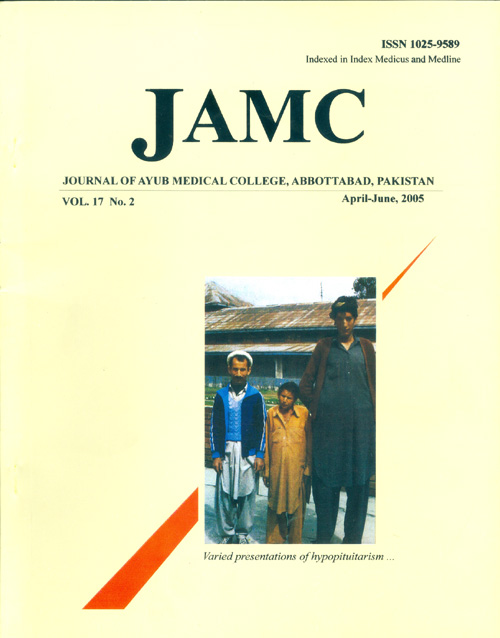PRESENTATION AND MANAGEMENT OUTCOME OF ECLAMPSIA AT AYUB TEACHING HOSPITAL, ABBOTTABAD
Abstract
Background: This study was carried out evaluate to epidemiology, clinical presentation and prognostics aspects of patients presenting with eclampsia. Methods: This study was carried out at Gynae C unit of Ayub Teaching Hospital Abbottabad from 1st July 2003 to 31st October 2004. All patients presenting with eclampsia to the labor ward were included in the study. The diagnosis was based on history and confirmed on clinical findings of hypertension, oedema, proteinuria superimposed with fits. Patients with history of fits during pregnancy, labor and peurperium other than eclampsia were excluded from study. History physical findings and base line investigation were recorded on a proforma. Results: A total of 2100 admissions were made in the labor ward during this period and out of them 68 cases (3.23 %) were of eclampsia. Out of them 28 were primigravidae, 14 multigravidae and 26 grandmultigravidae. The seasonal frequency of cases was 29.41% in winters, 42.64% in autumn, 19.11% in summers and 8.82% in spring. Out of these 11.76% cases were complicated with retroplacental haemorrage and the same number with aspiration pneumonia, while Cerebrovascular Accident (2.94%) Acute tubular necrosis (2.94%) and Disseminated intravascular clotting (4.4%) were also seen. Among the new borns prematurity was found to be the major cause of perinatal mortality. Conclusion:Eclampsia is a dreadful complication of Pre Eclamptic Toxemia of pregnancy associated with high perinatal and maternal mortality. A qualitative and quantitative improvement in prenatal consultation should make it possible to reduce incidence of eclampsia measuring arterial blood pressure daily during antenatal period and for at least 14-days postpartum appears to be necessary for diagnosis and treatment for all cases of hypertension.
Keywords: Eclampsia, PET, Pregnancy
References
Eclampsia Trial Collaborative group. Which anti convulsant for women with eclampsia? Evidence from the collaborative Eclampsia Trial. Lancet 1995;345:1455-63.
Drife J. Lewis G. editors. Why Mothers Die, Report on the confidential Enquiry into Maternal Deaths in the United Kingdom. 1997-1999 London; RCOG Press, 2001
Piercy CN. In: Handbook of Obstetric medicine. Isis Medical Media, Oxford.1997.
Chelsey LC. A short history of eclampsia. Obstet Gynecol 1974;43:599-602
Douglous KA, Redman CWG. Eclampsia in the United Kingdom. BMJ 1994:309:1395-1400
O' Brien MD, Gilmour-WhiteS. Epilepsy & Pregnancy. BMJ 1993;307:492-5.
Begum R, Begum A, Bullongh C, Johnson RB. Reducing maternal mortality from Eclampsia using Magnesium Sulphate. Eur J Obstet Gynecol Reprod Biol 2000;92:223-4.
Eclampsia Working Group: Eclampsia in Bangladesh, a review & a guide line. Bangladesh J Obstet Gynaecol 1996;12:1-25.
Campbell DM, Mac Gallivray I. Pre-eclampsia in second pregnancy. Br J Obstet Gynaecol 1985;92:131-40
Fisher KA, Luger A, Spargo BH, Lindheimer MD.Hypertension in pregnancy, clinical pathological correlatioins & remote prognosis. Medicine 1981;60:267-76.
Witlin AG, Saade GR, Mattar F, Sibai BM. Predictors of neonatal outcome in women with severe pre-celampsia or Eclampsia between 24 & 33 weeks gestation. Am J Obstet Gynecol 2000;182:607-11
Moodley J, Daya P. Eclampsia a continuing problem in the developing world. Int J Gynecol Obstet 1993;44:9-14.
Andelusi B, Ojengbede OA. Reproductive performance after Eclampsia. Int Obstet Gynecol 1986;24:183-9
Chelsey LC, Annitto JE, Cosgrove RA. The familial factor in toxaemia of pregnancy. Obstet Gynecol 1968;32:303-5
Sibai BM, Sarinoglu C, Mercer BM. Eclampsia vil. Pregnancy outcome after Eclampsia & long term prognosis. Am J Obstet Gynecol 1992;166:1757-61.
Downloads
How to Cite
Issue
Section
License
Journal of Ayub Medical College, Abbottabad is an OPEN ACCESS JOURNAL which means that all content is FREELY available without charge to all users whether registered with the journal or not. The work published by J Ayub Med Coll Abbottabad is licensed and distributed under the creative commons License CC BY ND Attribution-NoDerivs. Material printed in this journal is OPEN to access, and are FREE for use in academic and research work with proper citation. J Ayub Med Coll Abbottabad accepts only original material for publication with the understanding that except for abstracts, no part of the data has been published or will be submitted for publication elsewhere before appearing in J Ayub Med Coll Abbottabad. The Editorial Board of J Ayub Med Coll Abbottabad makes every effort to ensure the accuracy and authenticity of material printed in J Ayub Med Coll Abbottabad. However, conclusions and statements expressed are views of the authors and do not reflect the opinion/policy of J Ayub Med Coll Abbottabad or the Editorial Board.
USERS are allowed to read, download, copy, distribute, print, search, or link to the full texts of the articles, or use them for any other lawful purpose, without asking prior permission from the publisher or the author. This is in accordance with the BOAI definition of open access.
AUTHORS retain the rights of free downloading/unlimited e-print of full text and sharing/disseminating the article without any restriction, by any means including twitter, scholarly collaboration networks such as ResearchGate, Academia.eu, and social media sites such as Twitter, LinkedIn, Google Scholar and any other professional or academic networking site.










